Related Research Articles

The 1880s was a decade of the Gregorian calendar that began on January 1, 1880, and ended on December 31, 1889.

The lead–acid battery was invented in 1859 by French physicist Gaston Planté and is the earliest type of rechargeable battery. Despite having a very low energy-to-weight ratio and a low energy-to-volume ratio, its ability to supply high surge currents means that the cells have a relatively large power-to-weight ratio. These features, along with their low cost, make them attractive for use in motor vehicles to provide the high current required by starter motors.
An Earth battery is a pair of electrodes made of two dissimilar metals, such as iron and copper, which are buried in the soil or immersed in the sea. Earth batteries act as water activated batteries and if the plates are sufficiently far apart, they can tap telluric currents. Earth batteries are sometimes referred to as telluric power sources and telluric generators.

Electrification is the process of powering by electricity and, in many contexts, the introduction of such power by changing over from an earlier power source. The broad meaning of the term, such as in the history of technology, economic history, and economic development, usually applies to a region or national economy. Broadly speaking, electrification was the build-out of the electricity generation and electric power distribution systems that occurred in Britain, the United States, and other now-developed countries from the mid-1880s until around 1950 and is still in progress in rural areas in some developing countries. This included the transition in manufacturing from line shaft and belt drive using steam engines and water power to electric motors.
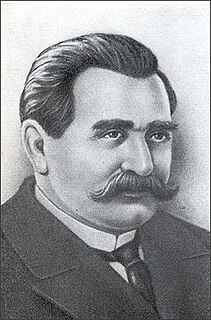
Alexander Nikolayevich Lodygin, known after immigration to US as Alexandre de Lodyguine was a Russian electrical engineer and inventor, one of inventors of the incandescent light bulb.
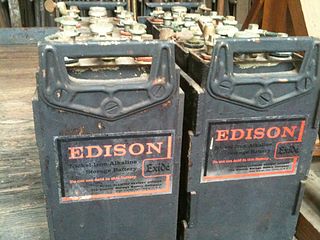
The nickel–iron battery is a rechargeable battery having nickel(III) oxide-hydroxide positive plates and iron negative plates, with an electrolyte of potassium hydroxide. The active materials are held in nickel-plated steel tubes or perforated pockets. It is a very robust battery which is tolerant of abuse, and can have very long life even if so treated. It is often used in backup situations where it can be continuously charged and can last for more than 20 years. Due to its low specific energy, poor charge retention, and high cost of manufacture, other types of rechargeable batteries have displaced the nickel–iron battery in most applications.

A dry cell is a type of electric battery, commonly used for portable electrical devices. It was developed in 1886 by the German scientist Carl Gassner, after development of wet zinc-carbon batteries by Georges Leclanché in 1866. The modern version was developed by Japanese Yai Sakizo in 1887.

Sebastian Pietro Innocenzo Adhemar Ziani de Ferranti was a British electrical engineer and inventor.
Charles Hesterman Merz was a British electrical engineer who pioneered the use of high-voltage three-phase AC power distribution in the United Kingdom, building a system in the North East of England in the early 20th century that became the model for the country's National Grid.
Camille Alphonse Faure was a French chemical engineer who in 1881 significantly improved the design of the lead-acid battery, which had been invented by Gaston Planté in 1859. Faure's improvements greatly increased the capacity of such batteries and led directly to their manufacture on an industrial scale. The patents were assigned to the Société La Force et la Lumière. The right to use these patents in the British Isles were sold to the Faure Electric Accumulator Company on 29 March 1881. Faure was a consultant engineer with William Edward Ayrton for this company.
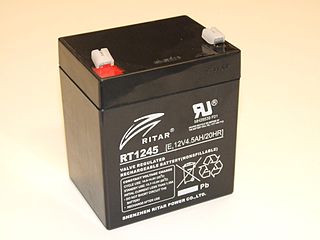
A valve regulated lead–acid (VRLA) battery, commonly known as a sealed lead–acid (SLA) battery, is a type of lead–acid battery characterized by a limited amount of electrolyte absorbed in a plate separator or formed into a gel; proportioning of the negative and positive plates so that oxygen recombination is facilitated within the cell; and the presence of a relief valve that retains the battery contents independent of the position of the cells.
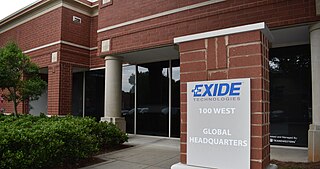
Exide Technologies is an American multinational lead-acid batteries manufacturing company. It manufactures automotive batteries and industrial batteries. It is based in Milton, Georgia, United States.

Henri Owen Tudor was a Luxembourg engineer, inventor, and industrialist. He developed the first commercially usable lead-acid battery.
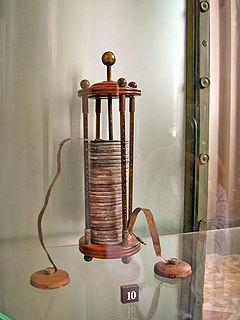
Batteries provided the main source of electricity before the development of electric generators and electrical grids around the end of the 19th century. Successive improvements in battery technology facilitated major electrical advances, from early scientific studies to the rise of telegraphs and telephones, eventually leading to portable computers, mobile phones, electric cars, and many other electrical devices.

Anthony Reckenzaun was an electrical engineer who worked in the UK and the United States.
Moritz Immisch was an Electrical engineer, watchmaker and inventor.
Chloride Electrical Storage Company was a British company that manufactures and sells storage batteries. The company has approximately 35 subsidiary companies in the UK, several being dormant, most are wholly owned and some 22 subsidiary and associated companies in overseas countries.

Charles Jeantaud (1840-1906) was a French engineer who invented the parallelogram steering linkage in 1878.
Thomas Parker was an English electrical engineer, inventor and industrialist. He patented improvements in lead-acid batteries and dynamos, and was a pioneer of manufacturing equipment that powered electric tramways and electric lighting. He invented the smokeless fuel Coalite. He formed the first company to distribute electricity over a wide area.
Michael Radcliffe Ward was an English electrical engineer and automotive pioneer. After making engineering innovation in electric lighting, he went on to develop electric buses.
References
- 1 2 "The Faure Electric Accumulator Company". The Railway News (4 March 1882). 1882.
- ↑ "Faure Accumulator Co". www.gracesguide.co.uk. Graces Guide. Retrieved 25 September 2020.
- ↑ "About batteries: the pasted plate". www.hefra.nl. Accuverkoop Hefra. Retrieved 25 September 2020.